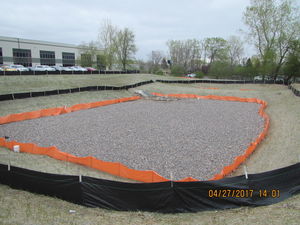
MCM 5 Post-Construction Stormwater Management
Introduction
Paved surfaces exacerbate the negative impacts to stormwater, including a increasing the stormwater discharge volume and pollutants in stormwater. Managing stormwater onsite post-construction is the more effective way to mitigate these impacts. Minimum Control Measure (MCM) 5 of the municipal seperate storm sewer system (MS4) General Permit requires permittees to have and enforce a post-construction stormwater management program that prevents or reduces stormwater pollution in new- and re- development projects.
Requirements
The post-construction stormwater management program should include:
- A regulatory mechanism that requires proposers of construction activity to submit site plans with post-construction stormwater management best management practices (BMPs)
- A regulatory mechanism that requires the use of green infrastructure.
- A regulatory mechanism that specifies that there will be no net increase in stormwater volume, total suspended solids (TSS), and total phosphorus (TP) from new development projects; and a net decrease in volume, TSS, and TP for redevelopment projects. See MPCA this fact sheet for the different methodologies to employ to meet this requirement.
- A regulatory mechanism that prohibits infiltration in certain situations, and restricts it in others, as described here.
- Mitigation provisions if TSS and TP cannot be managed onsite.
- A long term maintenance agreement for private structural stormwater BMPs. We have three templates available for your use, a basic maintenance agreement, a maintenance agreement for rain gardens, and a maintenance agreement for stormwater quality treatment facilities.
- Site plan review procedures to ensure the post-construction stormwater management is in accordance with the regulatory mechanism. See [1] for more information on what to look for during the site plan review.
- All documentation described here.
Additional resources
- EPA MCM 5 guidance - EPA's guidance and suggested BMPs for an effective post-construction stormwater management program
- MPCA Minimal Impact Design Standards guidance - MPCA fact sheet on Minimal Impact Design Standards (MIDS) and how communities can adopt the MIDS requirements
- MPCA MCM 5 Technical Support guidance - MPCA guide to how to comply with MCM 5 post-construction stormwater management requirements
